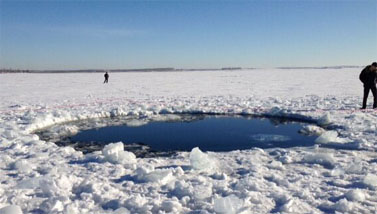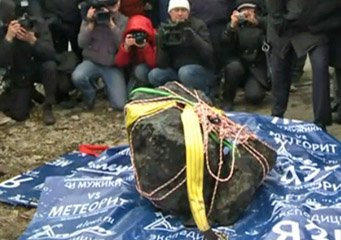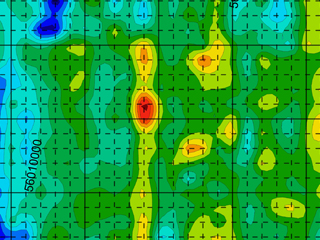After an 8-month salvage effort, today divers finally brought a half-ton fragment of the Chelyabinsk meteorite up from the murky bottom of Russia's Lake Chebarkul and onto dry land.

After the Chelyabinsk blast, local officials were directed to this fresh hole in the thick ice covering Lake Chebarkul, about 45 miles (70 km) west of the city. Some evidence suggests that a large fragment of the meteorite created the 25-foot (8-m) hole when it plunged through the ice and now lies in pieces on the lake's murky bottom.
Andrey Orlov / RT.com
Soon after a mini-asteroid roared over Chelyabinsk, Russia, on February 15th, locals discovered a 25-foot (8-m) hole in the ice covering Lake Chebarkul. The lake is about 45 miles (70 km) west of Chelyabinsk, and for 8 months meteorite researchers (and collectors) around the world have wondered whether one or more massive fragments ended up on the lake's murky bottom.
Just a few weeks after the once-in-a-century event, researchers from nearby Ural Federal University released a tantalizing magnetometer scan hinting that something big was down there, but the months afterward brought only vague or unsubstantiated reports that an object up to 20 feet across had been located.

After planning its extraction for 8 months, divers finally retrieved a half-ton chunk of stone — likely a fragment of the Chelyabinsk mini-asteroid — from the bottom of Lake Chebarkul on October 16, 2013.
BBC
The waiting ended today, when a team of divers and researchers removed a 5-foot long stone from the lake bottom and dragged it onto the shore. Although tests haven't yet confirmed that it truly is a piece of the Chelyabinsk impactor, the giant rock sure looks the part. members of the recovery team attempted to weigh it, but their scale broke during the measurement. The last reading was 570 kg (1,250 pounds).
Reporters on the scene say the stone broke into three pieces (apparently along known fractures). But there wasn't much time for inspection, as Russian researchers bundled up the fragments and whisked them away after about 10 minutes of show 'n' tell.
"It’s a typical meteorite, judging by its appearance," Viktor Grokhovsky (Ural Federal University) told a reporter for RIA Novosti. "There's no doubt about that." Grokhovsky says the stone has a thick melted crust and other characteristics typical of pieces of the Chelyabinsk meteorite.

A map of the magnetic field measured at the bottom of Lake Chebarkul. The area shown measures 100 by 60 meters. Red areas might indicate the location of large fragments of the Cherbakul meteorite, which fell in countless pieces across the region on February 15, 2013.
Ural Federal University
The magnetometer survey suggested that multiple masses lie at the bottom of Lake Chebarkul. A second fragment, with an estimated mass of 300 to 500 kg, was scheduled to be pulled out later today, but there's been no confirmation yet. In that location, the lake bottom is about 35 feet (10 m) deep and covered by a thick layer of silt.
Earlier this year, Svend Buhl and Karl Wimmer painstakingly documented the locations of hundreds of smaller fragments scattered in an elongated strewnfield 45 miles long and 12 wide (70 by 20 km). They predicted that the most massive object, the one that fell in the lake, would weigh in at roughly 700 pounds (300 kg).
The Chelyabinsk impactor had an estimated diameter of about 54 feet (17 m) and a mass of roughly 10,000 metric tons. The vast majority of it was likely vaporized and pulverized to dust when it slammed into the atmosphere and released the kinetic energy equivalent of 470,000 tons of TNT, 30 times the explosive power of the Hiroshima bomb.
Two good videos showing the recovery are available online from the BBC (in English) and the CBC (sound but no commentary). For the truly captivated, there's an hour-long video here.
 0
0
Comments
You must be logged in to post a comment.